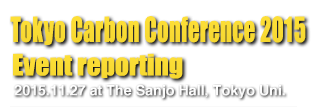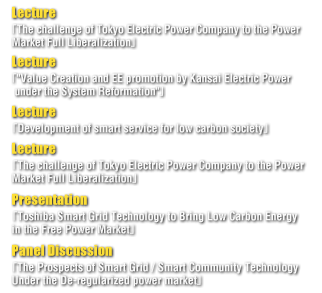The First Access successfully carried out the international symposium gTokyo Carbon Conference 2015 - How to develop Low Carbon Energy in the Liberalized Power Marketh on 27th November 2015. We welcomed executives from Tokyo Electric Power Company, Kansai Electric Power Company and Ennet Corporation.
Lecture
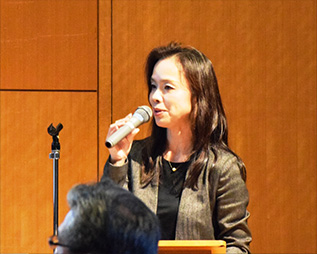
uThe challenge of Tokyo Electric Power Company to the Power Market Full Liberalizationv
Ms. Rieko Sato, Executive Officer, Vice President, Customer Service Company, TOKYO ELECTRIC POWER COMPANY
Tokyo Carbon Conference 2015 kicked off with the lecture of Ms. Rieko Sato, Vice President of Customer Service Company, TOKYO ELECTRIC POWER COMPANY, which is in charge of marketing of electricity in TEPCO.
As Japanfs largest power company TEPCO is presently supplying electricity to 30 million customers, other large utilities (such as Kansai Electric Power or Chubu Electric Power) and new market entrants would try to take as much as customers away from TEPCO, after the power market is liberalized in April 2016. Nevertheless, TEPCO is now facing with difficult conditions, such as compensatory payment, refunding and decommissioning of Fukushima Dai-ichi Nuclear Power Plant Accident, and uncertain restart of Kashiwazaki-Kaliwa Nuclear Power Plant unit 6E7. For those reasons, TEPCO is projected to face with tough corners after April 2016.
In the opening sentence, Ms. Sato strongly and clearly stated that TEPCO is committed to completely restore all concerned parties with Fukushima Nuclear Power Plant Accident. (As Ms. Sato was previously in charge of compensation for Fukushima Accident, her words looks undoubtedly credible.)
And with regard to the liberalization of electric power market, she described gThe quality of electric power is same, so electric power companies which can provide comprehensive energy solutions can only survive. Price competition would not become the maximum element at new market.h Subsequently she introduced TEPCOfs planned strategy, for instance Smart House, district heating and cooling, B to B service website gTEPCO Business Platformh, B to C service website gResidential House Solutionh. For example, they can advice customers who are using refrigerator for 10 years that they can reduce electricity cost by replacing to newest models.
Namely, we could learn that the market leader TEPCO is now preparing to play fair game with newcomers, not just beating them off with low prices. And Ms. Sato concluded her lecture with stating gWe will never forget Fukushima. Along with the decommissioning, we are to support each customer though fearless innovation.h
Lecture
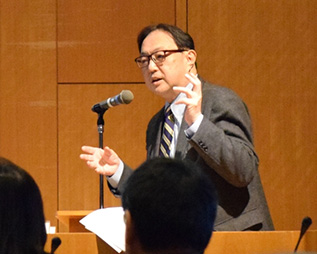
u"Value Creation and EE promotion by Kansai Electric Power under the System Reformation"v
Professor Kiyoshi Nishimura, General Manager, Marketing, The Kansai Electric Power Company, Incorporated
The second lecturer was Professor Kiyoshi Nishimura, the General Manager for Marketing at Kansai Electric Power. In addition to his assignment as Chief Marketing Strategist, Professor Nishimura has been teaching at Gakushu-in Univ, Kansei Gakuin Univ and Osaka Univ, and he has also written many books related with energy market. Well distinguished for his learning and wisdom, Professor Nishimura is known and described as gThe conscience of KEPCOh.
To start with, `Prof. Nishimura pointed out that;
EProfitable customers are very limited
ENo power market in the world is driven by jut price competition. Instead, the participants are struggling with non-exclusive items called gBundling Serviceh such as electric power, gas, oil, communication, etc.
and he added that gThe most profitable customer segment is the top 20 to 25 percent. Neither new comers nor regional power utilities can survive without these major clients.h He also pointed out that gThe dominant competitors would be companies which have direct contact points with customer, namely gas, cable TV, mobile phone, internet providersh.
With refer to KEPCO strategy, he described that the flagship missions against the liberalized market is how to build the platform, as well as how to create value on the platform. In particular, they will renew their product line by adding gas, communication, energy conservation, and security services. Equally important, KEPCO will not only try to provide full service for customers, but they will also contribute to build low carbon society through improving energy efficiency.
Lecture
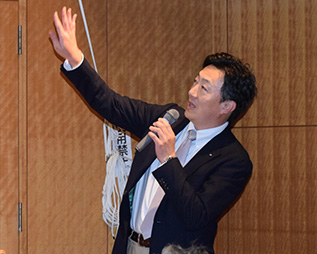
uDevelopment of smart service for low carbon societyv
Mr. Kazuya AKIYAMA, Executive Manager, Corporate Strategy Division, Ennet Corporation
Ennet was established on 2000 by NTT Facilities Inc.i40%j, Tokyo Gas Co.,Ltd.i30%j and Osaka Gas Co., Ltd.i30%j. And they have been the leading company of Japanese liberalized power market by 40% (formerly over 50%) share with more than 20,000 customers.
To date they have secured more than 200 power sources, including their own power stations, and facilities of NTT Facilities, Tokyo Gas. While their main power supply is natural gas, they also use renewables such as hydro, solar, wind and biomass. Thereby, the major function of Ennet is to match these 200 supply with 20,000 demands at (almost) exact timing, (almost) exact volume and LEAST cost. Most importantly, their competitive service is based on the unique IT technologies which is clearly shown on their company namegEnergy + Network = ENNETh.
For instance, despite 10% of power system costs 50 billion yen, they are used for only 2.5% in time length per year. Then, Ennet tries to cut the cost by shifting the demand out of peak. In this case, not only power company and customer but also SOCIETY can enjoy the benefit (Win = Win = Win) by their IT gSmart Serviceh technology.
While these Smart Services can dramatically reduce energy cost, Mr. Akiyama told us it is not easy to continue, mainly because the participation of customers is required to operate the system. In other words, Ennet is making effort to keep the customers interested in energy management. For example, they build in competition between participants, or they adopt bonus point system on saving energy.
Besides from asking customers to save energy, they have also started to cooperate with customers which operates co-generation plant. On this contract, Ennet can have access to additional power by controlling the output of plant. And they are also building smart communities with local governments.
Lecture
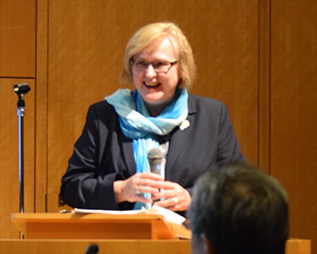
uThe challenge of Tokyo Electric Power Company to the Power Market Full Liberalizationv
Unscheduled Participant
Ms.Violeta GAIZAUSKAITE), Minister Plenipotentiary, Embassy of the Republic of Lithuania in Japan
At here, Ms. Violeta GAIZAUSKAITE) from Lithuania Embassy gave us a short presentation to introduce us how her country and Japan is in a similar situation.
Japan is to experience the deregulation of electric power market, following to a great sharp decline of nuclear power. And while the back ground is completely different, Lithuania is in the same process ahead of Japan.
At a time in the past , Lithuania was an exporter of electricity because we had Ignalina Nuclear Power Plant, the worldfs biggest at that day. However, as the reactor of Ignalina was the same model with Chernobyl Nuclear Power Plant, many countries express big concern for severe accident. Furthermore, Russia stepped back from supporting the operation of Ignalina Nuclear Power Plant after the disintegration of the Soviet Union. For these reasons, unit 1 and 2of the Ignalina was closed down on 2005 and 2009 respectively. And since then, Lithuania became an importer of energy. As it was a threat against the independence and security of energy, this issue was given high priority at that time.
However, after the Lithuanian power market was liberalized, the price level of electricity has declined sharply, now our price level is the lowest in whole EU countries.
Now you can see Lithuania and Japan is both experiencing the steep decline of nuclear power and the deregulation of electric power. I hope we can share our knowledge and join hands to overcome our challenges.
Presentation
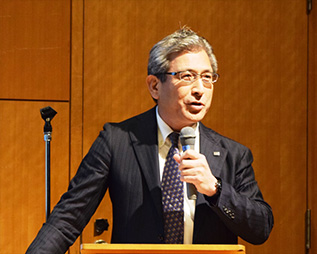
uToshiba Smart Grid Technology to Bring Low Carbon Energy in the Free Power Marketv
Mr. Shoji Takenaka, Executive Officer, Chief Fellow, TOSHIBA Corporation
It is our honor to welcome Mr. Shoji Takenaka, the Executive Officer of TOSHIBA Corporation, which is the world leading company for smart grid technology.
The electric power system is composed of hardware (generators, transformers, transmission linec.) and software (control system), and the importance of software is quite often considered less serious. However, we should underscore that in case power plants generate huge power, nobody can use electric equipment properly when the demand and supply of electricity donft meet. In other words, power companies should generate the needed QUANTITY of electricity at the needed TIME in every moment.
Before the liberalization of power market, the one and only dominant power company was both the supplier and operator of all electricity in Japanese power grid (Uni-directional). So it was a very favorable circumstance for them to stabilize the frequency and voltage. However, after the market was liberalized, many new power companies entered and un-controlled power began to flow into the grid (Bi-directional). Even worse, as most of the new player are not responsible for power transmission, the incentive to invest for power grid stabilization is predicted to decline sharply.
Hence, it would be substantially difficult to operate the power system compared with the age when the generation, transmission and distribution is vertically integrated. And as the investment for power system is sure to become insufficient, all players (government, power companies, grid operator) should struggle to stabilize the power supply. And of course, TOSHIBA will also contribute as a supplier by developing advanced technology with affordable cost.
Among all, here we would like to introduce gToshiba Storage Solutionh as one particularly notable power grid technology. We have developed various products, such as Grid StabilizationADemand LevelingAEV Charging, PV System, Grid Stabilization, Business and Households. And we are also trying to take the initiative of international standard of power storage.
For instance, lithium-ion battery has been paid great attention as an epoch-making storage technology. It is true that lithium-ion battery is capable to store high energy density power, but on the other hand, it is not suitable for large power usages. In line with all other leading companies, TOSHIBA as a supplier will continue challenge to develop state-of-art power technology.
Panel Discussion
uThe Prospects of Smart Grid / Smart Community Technology Under the De-regularized power marketv
Panelists;
EMs. Rieko Sato, TOKYO ELECTRIC POWER COMPANY
EProfessor Kiyoshi Nishimura, The Kansai Electric Power Company
EMr. Kazuya AKIYAMA, Ennet Corporation
EMr. Shoji Takenaka, TOSHIBA
Moderator;
Professor Jun Arima, Graduate School of Public Policy, Tokyo University
Professor Jun Arima, Graduate School of Public Policy, Tokyo University, lead the panel discussion.
In the wake of electricity liberalization, we can find plenty of new power services which we could never imagine at the era of regulated monopoly. In this respect I would like to pay my sincere regard to new power companies.
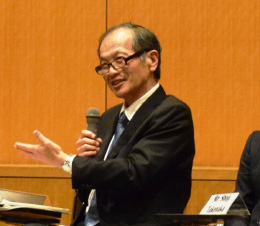 Prof. ArimaFNow I would like to ask you respectively about the meaning of gelectricity deregulationh. And will the price go down or up?
Prof. ArimaFNow I would like to ask you respectively about the meaning of gelectricity deregulationh. And will the price go down or up?
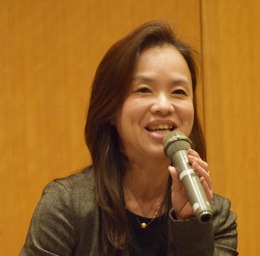 Ms. SatoFThe history shows not all deregulated power market is enjoying cheaper power price. Equally important, changeable consumers who easily switch power companies to the cheapest suppliers, is very limited.
And when we try to prepare best energy solution for many customers, we need to prepare a wide variety of power supply service.
Ms. SatoFThe history shows not all deregulated power market is enjoying cheaper power price. Equally important, changeable consumers who easily switch power companies to the cheapest suppliers, is very limited.
And when we try to prepare best energy solution for many customers, we need to prepare a wide variety of power supply service.
Mr. NishimuraFIn the deregulated electricity market, there is no guniversal producth which would be the cheapest menu for all consumers. For example, heavy users of cable TV would most benefit to buy power from cable TV companies. As well, heavy users of gas should find their cheapest product at gas suppliers. It is true that some price comparison websites has started, but they just show only the open-announced official prices.
Mr. AkiyamaFFirst of all, we would like to point out that the power price of Japan is generally moving down. And as new power companies are under assumption of gcheaper price than utilitiesh, we are making great effort to offer lowest electricity price. If this requirement does not change, the number of new power companies would dramatically come down
Prof. ArimaFUK, the global pioneer of deregulation, has experienced a steep price hike at 2014. Additionally, the consumers suffered from too many menu of power companies. So the UK government needed to guide the utilities to minimize their product lines.
And along with the liberalization, the power industry should also try to promote the low carbon society. How would the power companies comply with this? As well, how would Toshiba utilize the latest information technologies toward low carbon solutions?
Mr. TakenakaFThe demand response technology is not treated as important at present market. However, it would become one of the main function of balancing the demand and supply within this ten or fifteen years.
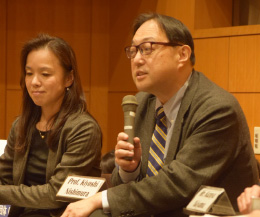 Mr. NishimuraFWe cannot lower the price only at the result of sales competition. And with refer to the relation between global warming and deregulation, the best way to minimize the emission of global greenhouse gas is to increase the power generation of nuclear. If we need to change this, Japan government should develop more renewable energy plants, as well as demand response technology.
Mr. NishimuraFWe cannot lower the price only at the result of sales competition. And with refer to the relation between global warming and deregulation, the best way to minimize the emission of global greenhouse gas is to increase the power generation of nuclear. If we need to change this, Japan government should develop more renewable energy plants, as well as demand response technology.
Ms. SatoFFrom a standpoint of power generation, most newly installed power plants in Japan are coal fired which is most cost competitive. In this regard, the present power market is not directed for low carbon society.
On the other hand, the power demand would be automatically minimized with demand response, based on IOTiInternet of Thingsj technology.
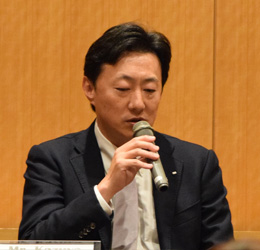 Mr. AkiyamaFThe grand design of future energy mix of Japan Government is based on a big amount of gpower conservationh. On that issue, new power producers can make a significant contribution.
Mr. AkiyamaFThe grand design of future energy mix of Japan Government is based on a big amount of gpower conservationh. On that issue, new power producers can make a significant contribution.
Prof. ArimaFAs Mr. Akiyama pointed out, the 2030 power mix plan which was published by Japan Government is based on g17 percent power conservationh precondition. In addition, Japan economy is proposed to continue 1.7% annual growth along with significant cut of energy consumption.
Therefore, the demand response technology would play a significant role to lower the demand. In the same way, the IOT technology which can automatically minimize the power demand should be the key to build low carbon technology.
Mr. NishimuraFAll of the newly planned coal fired power plants are located in East Japan (formerly supplied by Hokkaido, Tohoku and Tokyo Electric Power Companies, all in 50Hz) because nuclear power plant in this regions are projected NOT to restart. In view of this, future GHG emission in Japan is very much dependent on nuclear policy.
Prof. ArimaFHere we would like to open the floor for questions.
ParticipatorFMr. Takenaka, what do you see for the future of trend of IOT technology?
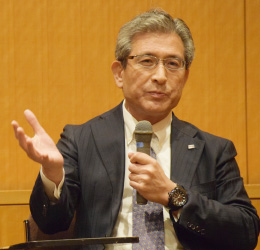 Mr. TakenakaFHydrogen technology would become our core competency, because hydrogen can not only a power source, but can also become the major factor of GHG emission reduction.
Mr. TakenakaFHydrogen technology would become our core competency, because hydrogen can not only a power source, but can also become the major factor of GHG emission reduction.
Generally speaking, it is very risky to refer to future technology. For example, when smart grid technology was introduced to Japan, the marketing section did not pay regard to it. However, as I believed it would be the principal technology in near future, I continued the development behind the back which finally produced big result nowadays. And as I feel the same passion with demand response now, we should keep focusing on it.
Finally, Professor Arima concluded the panel discussion as;
gNow the power market has liberalized. But the consumers should also change themselves as well. Today we learned that although traditional and new power companies prepare wide variety of power product, the consumers can never benefit if we stay the same. In other words, consumers should LEARN the new power market and FIND the best supplier and best menu for themselves.h

MC
Ms. Risako Yamamoto,
Public Relations Secretary, First Access
